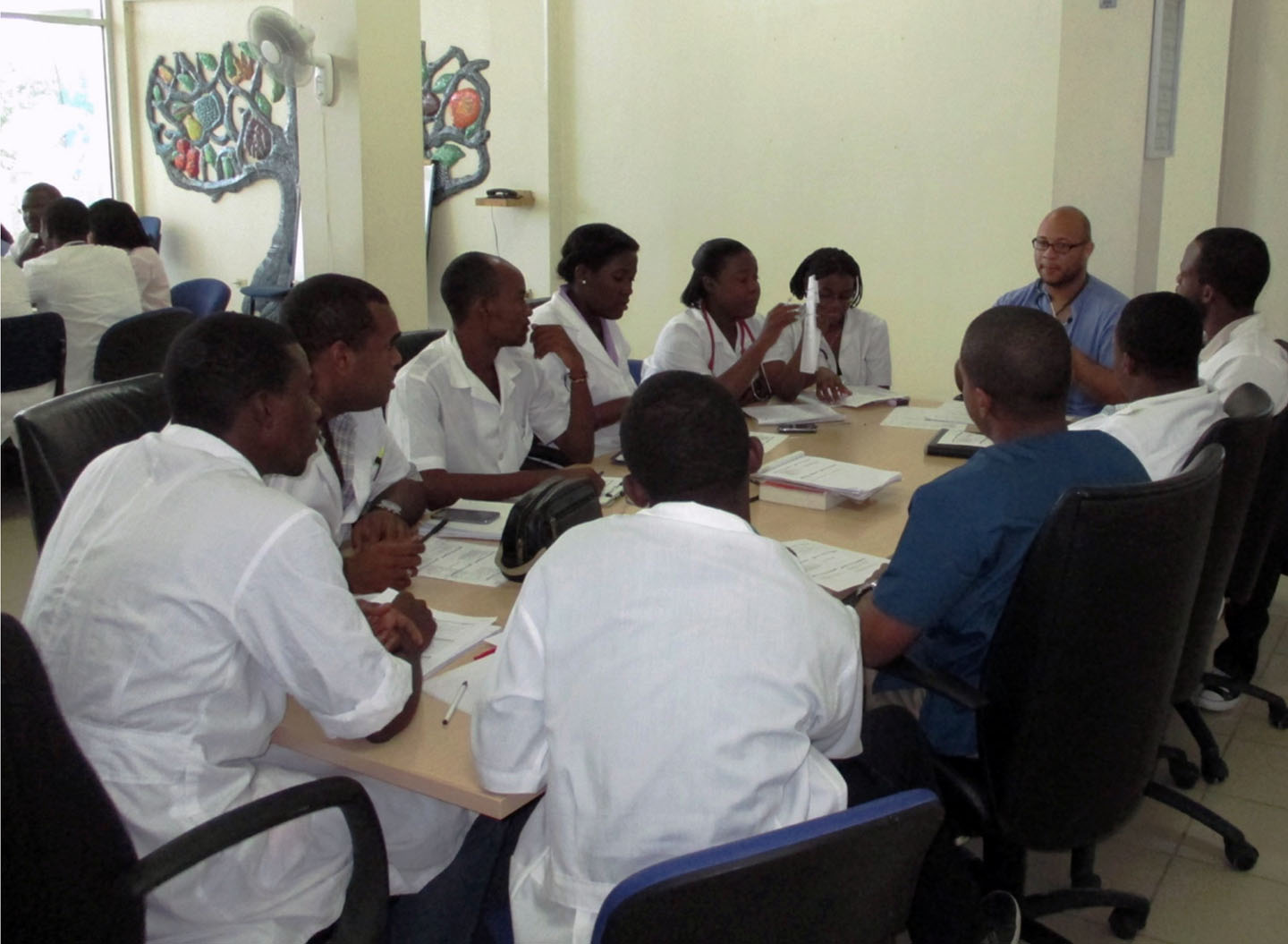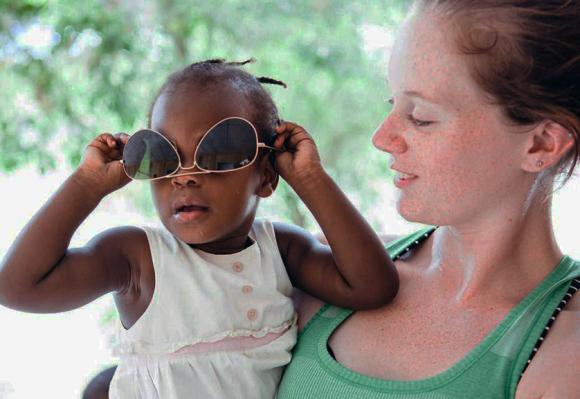PROVIDENCE, R.I. [Brown University] — Five years after the earthquake that horrified the world, Haitians are marking an anniversary and a deadline. Many of the aid organizations that rushed to the country to help are coming to the end of five-year contracts. Some were already pulling up stakes during the summer.
But when a delegation of Alpert Medical School professors and Lifespan doctors first came in March 2010 to Hôpital St. Damien, a children’s hospital two miles east of the Port-au-Prince airport in the town of Tabarre, they proposed to forge a long-term partnership to advance pediatric medical education and public health, said Dr. Michael Koster — not merely to pick up the proverbial pieces left by quake.
“In terms of measuring what kind of progress has happened since the earthquake, it’s hard find that pulse because there wasn’t something to go back to,” said Koster, clinical assistant professor of pediatrics and a physician at Hasbro Children’s Hospital. “Going back to where it was before the earthquake is not where Haiti wants to be.”

Disaster relief was essential, but physician training and public health outreach are crucial for long-term improvement in the world’s poorest nation.
By their own efforts and with outside help, the 10 million people of Haiti have rebuilt much after the 7.0-magnitude earthquake that killed about 300,000 people and injured about 300,000 more on Jan. 12, 2010. There are tangible signs of hope, for instance in rebuilt infrastructure. But problems such as political instability, new disasters including a major flood in the north last November, and ongoing outbreaks of cholera and chikingunya virus provide abundant signs that complex problems remain in the notoriously impoverished country.
“The next few years are really going to show what the effects of the impact of these relief organizations were,” said public health master’s student Sarah Davey, who has been studying the impact of a program at St. Damien that trained Haitian doctors in pediatric HIV care.
Throughout it all, Brown University’s Global Health Initiative and Hasbro Children’s Hospital have maintained their strong partnership the hospital, now acting as one of six U.S. academic medical partners in the St. Damien Collaborative. As part of the collaborative, Hasbro and Brown, working through the Alpert Medical School, the Brown University International Advanced Research Institutes (BIARI) program, and more recently the School of Public Health, have engaged in the partnership through medical education programs and clinical services, an ongoing student, resident, and faculty exchange, and rigorous program evaluation.
“From the initiatives and programs we’ve been involved with, we’ve seen significant progress,” Koster said, “and we look forward to our ongoing and mutually beneficial partnership.”
Medical education
In January 2014, for example, Brown residents, students, and medical faculty, including Koster, Dr. Allison Lemkin and Dr. Kahleb Graham, visited St. Damien toting four new teaching cases. One, for example, presents the situation of a child with seizures, while another presents a newborn with a fever. Brown students and faculty worked with Haitian colleagues to translate the cases into French and then piloted the cases with fifth- and sixth-year medical students at the University of Notre Dame Haiti (UNDH) and St. Damien with help from Haitian UNDH collaborators Dr. Audiline Metayer and Dr. Theony Deshommes. This month, Brown professor and physician Lisa Denny, teaching fellow Dr. Robyn Wing, and pediatric residents Dr. Alison Labadie and Dr. Renee Kleris will bring four more cases.
“Going back to where it was before the earthquake is not where Haiti wants to be.”
— MICHAEL KOSTER
Brown faculty are also working with collaboration partners to develop “order sets,” which provide step-by-step guidance for diagnosing and treating different conditions such as pneumonia, malnutrition, sickle cell disease, and meningitis.
Medical residents from Brown and Hasbro have been traveling to St. Damien for training and to provide care — on rotation — for years, since before the collaboration formed with other U.S. academic medical centers began, Koster said. Now that St. Damien has developed a residency program for newly trained Haitian doctors, the collaborating universities and hospitals will serve as rotation sites for them.
Faculty members have been part of a bilateral exchange all along. Koster spoke last January to the National Pediatric Congress on pneumococcal disease. Dr. Kimberle Chapin, professor of internal medicine, pathology, and laboratory medicine, came to St. Damien in September 2013 to support initiatives in the microbiology lab there.
Meanwhile, St. Damien medical faculty and staff have visited Brown. Haitian medical intern Dr. Theony Deschommes, attended BIARI in 2014, preceded by Dr. Maria Excellent in 2013 and Dr. Jacqueline Gautier in 2011.
In October 2013, Brown hosted the collaborative’s annual meeting, complete with a continuing medical education program for local doctors and a gala to raise money for St. Damien.
Public health evaluation
Sarah Davey, the public health graduate student, first went to Haiti last summer for her research. With funding from the U.S. President’s Emergency Plan for AIDS Relief (PEPFAR), St. Damien has been training scores of Haitian doctors to confront an HIV epidemic in which roughly 3 percent of the nation’s children are infected. Davey is assessing how well the program worked.
The stakes are high in a country with so many other infectious disease outbreaks. Children with suppressed immune systems are more susceptible to tuberculosis and chikungunya, for example. The latter infection causes high fever and prolonged joint pain.
“For children that was such a crippling disease,” said Davey, who herself contracted chikungunya as it swept the island last summer.
To make her assessment, Davey has been studying the literature on similar programs in other developing countries for comparison. She also led the development of a survey for 41 doctors who graduated from the program, which began in 2007, to determine what they took away from their experience.
About half the doctors have responded so far — not a bad rate in a country with spotty Internet access and a high churn of cell phone numbers — but it’s apparent in the initial data that the program succeeded in key ways, Davey said. Pre- and post-tests of the doctors’ HIV knowledge show a clear increase. Davey has also been able to document an increase in HIV specialty care for children among doctors who engaged in the program.
Davey’s work is also helping to reknit the network between the classes of HIV-trained doctors and the hospital.
Because PEPFAR funding for the program has run out, Davey’s evaluation may become even more important than she first thought.
“The paper has shifted from being more of a program evaluation to almost a needs assessment,” she said. “The clinic will be able to use it as a publication for their cause to get more funding.”
While she’s there, Davey will also help the hospital and St. Luke’s Hospital, its adult-oriented counterpart, with other grant writing.
In this respect and many others, as St. Damien has continued to grapple with its share of the challenges of life in Haiti, Brown remains a working partner.

